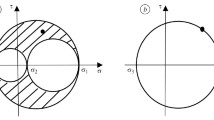Abstract
The variable amplitude fatigue data were statistically analyzed to determine the effect of spectrum type for multiple comparisons between means. According to the results, the differences between the fatigue lives of the specimens cycled with the ST and MT spectra were not significant at either equivalent stress range. The stress ratio has no significant effect on variable amplitude fatigue strength unlike the constant amplitude fatigue. Therefore, all ST and MT data were combined and analyzed as one set of variable amplitude fatigue data regardless of stress ratio. In comparison with the constant amplitude mean S-N line, the data points fell on both sides of the line atf r =94 N/mm2, to the right at 80 N/mm2 with one exception, and entirely to the right at 63 N/mm2. And, the equivalent stress range model based on the mean S-N line and mean fatigue limit overestimates the fatigue strength in comparison of the constant and variable amplitude fatigue data with the predicted mean S-N curves for ST spectrum loading.
Similar content being viewed by others
References
Albrecht, P. and I.M. Friedland, “Fatigue-Limit Effect on Variable-Amplitude Fatigue of Stiffener.”Journal of the Structural Division, American Society of Civil Engineers,December 1979, Vol. 105, No. ST12.
Albrecht, P., and I.M. Friedland, “Fatigue-Limit Effect on Variable-Amplitude Fatigue of Stiffeners.”Journal of the Structural Division, American Society of Civil Engineers,December 1979, Vol. 105, No. ST12.
Albrecht, P., H. Lu, K.S. Jung, H. Liu, and J. Cheng, “Long Life Variable-Amplitude Fatigue Strength of Wleded Steel Bridge Details” Publication no. FHWA/RD-94/108, Federal Highway Administration, Virginia, Sep., 1994, pp. 8–18.
C.G. Schilling, K.H. Klippstein, J.M. Barsom, and G.T. Blake, “Fatigue of Welded Steel Bridge Members under Variable Amplitude Loadings”. NCHRP Report 188, Transportation Research Board, National Research Council, Washington, DC, 1978.
G.P. Tilly, and D.E. Nunn, “Variable Amplitude Fatigue in Relation to Highway Bridges”.Proceeding of the Institute of Mechanical Engineers, (England) 1980, vol. 194, no. 27.
K.H. Klippstein, and C.G. Schilling, “Pilot Study on the Constant and Variable Amplitude Behavior of Transverse Stiffener Welds”. Special Issue on Fatigue and Fracture,Journal of Constructional Steel Research, 1989, vol. 12, no. 3 and 4, pp. 229–252.
R.E. Snyder, G.E. Jr. Linkins and F. Moses, “Loading Spectrum Experienced by Bridge Structures in the United States”. Publication no. FHWA/RD-85/012, Federal Highway Administration, McLean, Virginia, 1985.
R.H. McCuen, “Statistical Methods for Engineers”, Prentice-Hall, pp. 195–196.
W. Wright, and P. Albrecht, “Crack Growth Rates in Structural Steels under Constant and Variable Amplitude Loading”. Civil Engineering Report, University of Maryland, College Park, Maryland, 1990.
Author information
Authors and Affiliations
Corresponding author
Additional information
The manuscript for this paper was submitted for review on March 25, 2002.
Rights and permissions
About this article
Cite this article
Woo, SI., Jung, KS. & Albrecht, P. Fatigue behavior of transverse stiffener subjected to variable amplitude loading. KSCE J Civ Eng 6, 151–160 (2002). https://doi.org/10.1007/BF02829132
Issue Date:
DOI: https://doi.org/10.1007/BF02829132




